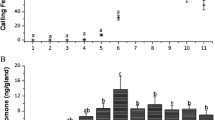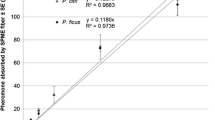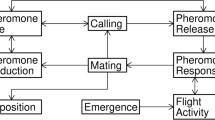Abstract
The effects of female sex pheromone concentration and time of day on behavioral responses of male brown-banded cockroaches were monitored with a two-choice olfactometer. The duration of each behavior or behavioral event in a deterministic response sequence and the probabilities of behavioral transitions were analyzed. Pheromone concentration had a significant effect on all behaviors in the response sequence. The time of testing, relative to the entrainment photoperiodic regime, significantly affected behavioral events early in the sequence but not later-occuring behaviors. Although the probability of males choosing the pheromone rather than the solvent control was a function of the pheromone concentration, it was independent of the time of testing. By affecting the probability of behavioral transitions, the pheromone concentration and time of testing determined the number of insects exhibiting specific behaviors in the response sequence. The behavioral response sequence can be characterized by probabilities of behavioral transitions along with latencies of early behavioral acts.
Similar content being viewed by others
References
Baker, T. C., Meyer, W., and Roelofs, W. L. (1981). Sex pheromone dosage and blend specificity of response by oriental fruit moth males.Entomol. Exp. Appl. 30: 269–279.
Bell, W. J. (1982). Pheromones and behaviour. In Bell, W. J., and Adiyodi, K. G. (eds.),The American Cockroach, Chapman and Hall Press, New York, pp. 371–298.
Bell, W. J., Burns, R. E., and Barth, R. H., Jr. (1974). Quantitative aspects of the male courting response in the cockroachByrostria fumigata (Guerin) (Blattaria).Behav. Biol. 10: 419–433.
Bradshaw, J. W. S., Baker, R., and Lisk, J. C. (1983). Separate orientation and releaser components in a sex pheromone.Nature (London) 304: 265–267.
Cardé, R. T. and Hagaman, T. E. (1983). Influence of ambient and thoracic temperatures upon sexual behaviour of the gypsy moth,Lymantria dispar.Physiol. Entomol. 8: 7–14.
Cardé, R. T., Baker, T. C., and Roelofs, W. L. (1975). Ethological function of components of a sex attractant system for Oriental fruit moth males,Grapholitha molesta (Lepidoptera: Tortricidae).J. Chem. Ecol. 1: 475–491.
Castrovillo, P. J., and Cardé, R. T. (1979). Environmental regulation of female calling and male pheromone response periodicities in the codling moth (Laspeyresia pomonella).J. Insect Physiol. 25: 659–667.
Hagaman, T. E., and Cardé, T. T. (1984). Effect of pheromone concentration on organization of preflight behaviors of the male gypsy moth,Lymantria dispar (L.)J. Chem. Ecol. 10: 17–23.
Hales, R. A., and Breed, M. D. (1983). Female calling and reproductive behavior in the brown banded cockroach,Supella longipalpa (F.) (Orthoptera: Blattellidae).Ann. Entomol. Soc. Am. 76: 239–241.
Hall, M. J. R. (1980). Circadian rhythm of proboscis extension responsiveness in the blowfly: Central control of threshold changes.Physiol. Entomol. 5: 223–233.
Hawkins, W. A., and Rust, M. K. (1977). Factors influencing male sexual response in the American cockroachPeriplaneta americana.J. Chem. Ecol. 3: 85–99.
Haynes, K. F., and Baker, T. C. (1985). Sublethal effects of permethrin on the chemical communication system of the pink bollworm moth,Pectinophora gossypiella.Arch. Insect Biochem. Physiol. 2: 283–293.
Haynes, K. F., Li, W.-G., and Baker, T. C. (1986). Control of pink bollworm moth (Lepidoptere: Gelechiidae) with insecticides and pheromones (Attracticide): Lethal and sublethal effects.J. Econ. Entomol. 79: 1466–1471.
Liang, D., and Schal, C. (1990). Circadian rhythmicity and development of the behavioural response to sex pheromone in male brown-banded cockroaches,Supella longipalpa. Physiol. Entomol. 15, in press.
Linn, C. E., Jr., and Roelofs, W. L. (1983). Effect of varying proportions of the alcohol component on sex pheromone blend discrimination in male Oriental fruit moths.Physiol. Entomol. 8: 291–306.
Linn, C. E., Jr., and Roelofs, W. L. (1984). Sublethal effects of neuroactive compounds on pheromone response thresholds in male Oriental fruit moths.Arch. Insect Biochem. Physiol. 1: 331–344.
Linn, C. E., Jr., and Roelofs, W. L. (1988). Temperature modulation of behavioural thresholds controlling male moth sex pheromone response specificity.Physiol. Entomol. 13: 59–67.
Payne, T. L., Shorey, H. H., and Gaston, L. K. (1970). Sex pheromone of noctuid moths: Factors influencing antennal responsiveness in males ofTrichoplusia ni. J. Insect Physiol. 16: 1043–1055.
Roelofs, W. L., and Cardé, R. T. (1977). Responses of Lepidoptera to synthetic sex pheromone chemicals and their analogues.Annu. Rev. Entomol. 22: 377–405.
Rust, M. K. (1976). Quantitative analysis of male responses released by female sex pheromone inPeriplaneta americana.Anim. Behav. 24: 681–685.
SAS Institute Inc. (1985).SAS User's Guide: Statistics, Version 5 ed., SAS Institute Inc., Cary, N.C.
Seelinger, G. (1985). Behavioural responses to female sex pheromone components inPeriplaneta americana.Anim. Behav. 33: 591–598.
Shorey, H. H. (1973). Behavioral responses to insect pheromones.Annu. Rev. Entomol. 18: 349–380.
Shorey, H. H. (1976). Environmental and physiological control of insect sex pheromone behavior. In Birch, M. C. (ed.),Pheromones, American Elsevier Press, New York, pp. 105–112.
Silverman, J. M. (1977). Patterns of response to sex pheromone by young and mature adult male cockroaches,Periplaneta americana.J. Insect Physiol. 23: 1015–1019.
Smith, A. F. (1988).Endogenous and Exogenous Factors Regulating Pheromone Production and Release in the Adult Female Brown-Banded Cockroach, Ph.D. thesis, Rutgers University, New Brunswick, N.J.
Sokal, R. R., and Rohlf, F. J. (1981).Biometry, 2nd ed., Freeman Press, New York.
Turgeon, J. J., McNeil, J. N., and Roelofs, W. L. (1983). Responsiveness ofPseudaletia unipuncta males to the female sex pheromone.Physiol. Entomol. 8: 339–344.
Wright, C. G. (1977). Sex pheromone release by virgin females of the brown-banded cockroach,Supella longipalpa (F.).J. Ga. Entomol. Soc. 12(4): 281–283.
Author information
Authors and Affiliations
Rights and permissions
About this article
Cite this article
Liang, D., Schal, C. Effects of pheromone concentration and photoperiod on the behavioral response sequence to sex pheromone in the male brown-banded cockroach,Supella longipalpa . J Insect Behav 3, 211–223 (1990). https://doi.org/10.1007/BF01417913
Accepted:
Issue Date:
DOI: https://doi.org/10.1007/BF01417913




